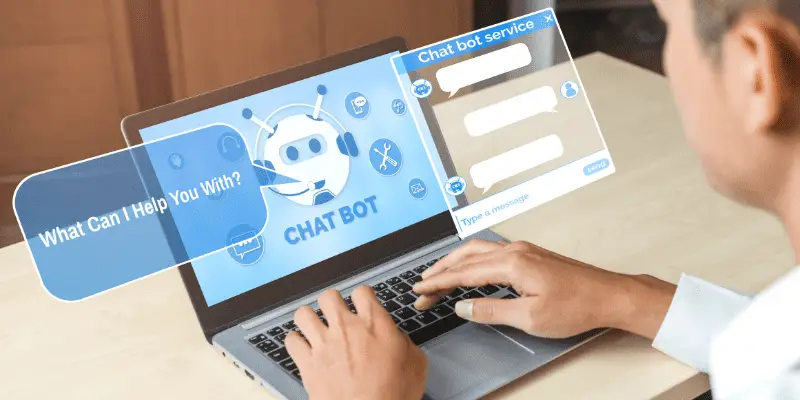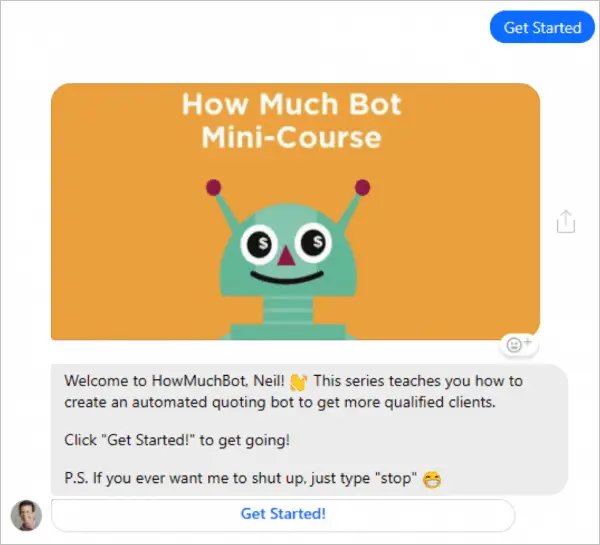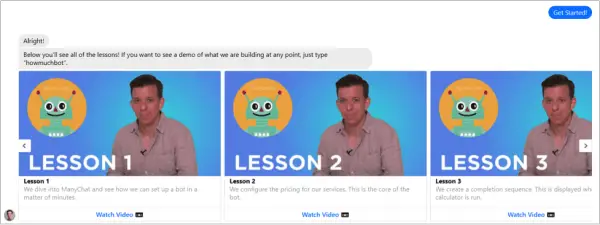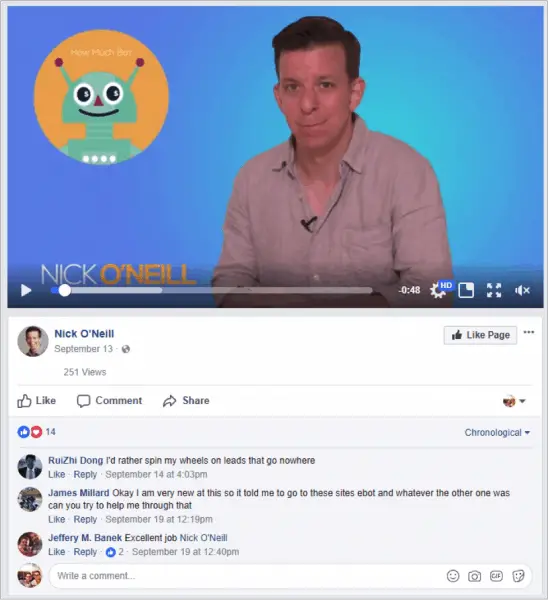Everyone and their mother recommends using your website to collect emails so that you can hopefully convert those email leads into paying customers later on.
It’s a good and sound recommendation.
By building your email list, you are creating an asset that is your own.
The only thing you need to consider is the email open rate.
According to GetResponse and this report, the email open-rates from January to June 2019 were at 19%.
But do you know what gets more than four times that? Real estate text marketing with chatbots, particularly Facebook Chats.
In this context, you may wonder if there is any chatbot for the real estate industry.
There is no specific chatbot for the real estate industry.
However, many different providers allow you to tailor their chatbot solutions to your individual real estate marketing needs.
This article will delve deeper into what a real estate Facebook chatbot can do to generate more real estate leads for your text marketing campaigns.
Chatbots for the Real Estate Industry – Pros
If we believe the statistics of this website, more than 90% of text messages are opened and read within three minutes.
Why is that?
When you leave your house next time, look around and observe the armies of people with future neck problems about to happen.
They only look at their devices, not the person next to them or their surroundings.
Also, most smartphones have notifications activated by default.
So, unless they deactivate notifications for all apps, people get notified when they receive a message.
So chats are real-time and a more advanced form of text messages.
And suppose you don’t want to cling to your phone or chat software 24/7.
In that case, a real estate Facebook chatbot can help automate the real estate text marketing process so you don’t go crazy.
And you could go crazy trying to fulfill expectations if you want to serve potential customers well when they expect a response to their questions almost instantly.
So, all real estate pros, investors, realtors, developers, etc., are expected to be reachable 24/7.
But how would you be able to do that by yourself?
What if you are on a call to discuss a significant deal with a partner wholesaler, or you are on a showing?
Well, you could have staff dedicated 24/7 to the communication needs of potential customers. But this can become costly.
Chatbots can come in handy in responding to inquiries on time because they can mimic almost all communication scenarios. Additionally, they help you to scale.
Suppose you have just a handful of customers texting you.
In that case, you might still be able to handle it somewhat alone, but what happens when ten people text you simultaneously while you are in the car driving to a property?
If you can handle this situation, you should apply for an air traffic controller job instead.
They have less stress.
So, What’s a Chatbot?
Do you remember the phone answering systems where you hear something like, “For English, please press 1. For Spanish, please press 2. If you want to speak with a sales representative, please press 3.”
Well, they still exist.
A chatbot does something similar, and it’s just a better version of an answering system.
It’s an automated text messaging answering system.
Don’t worry if someone wants to talk to a human.
You can configure a chatbot in a way that can connect the potential customer to a human representative.
You can program almost any communication or sales scenario with a chatbot. Still, usually, it’s programmed to answer basic questions (e.g., FAQs.) to prequalify or segment a new lead.
Depending on how the lead is segmented, it can direct the person to a determined website or even forward the lead to an actual human.
Chatbots usually use the application programming interface (API) of chat applications such as:
According to Statista 2018, Facebook’s Messenger beats them all with 103.55 million unique users per month in the U.S. alone.
According to Statista, in the year 2019, there were even 130 million users.
Due to such high user numbers, there is a good reason for focusing on Facebook chatbots for your real estate business.
Why Do People Prefer Texting?
In comparison to calling or emailing, it’s not intrusive.
I could see it for myself when this switch happened a few years ago.
I promoted a commercial property I am co-owner of.
In the beginning, more people were still calling, but they contacted me more via WhatsApp Messenger.
I think it also has to do with more and more people using their smartphones, which have faster access to the messenger they use all the time.
They just don’t want to talk that much over the phone anymore.
Other reasons this article found are:
- Customers are busier
- Customers don’t want to wait anymore
- It’s just a quick question
- People are always on the go
- No wish to talk
Why a Facebook Chatbot for Real Estate?
As already mentioned, you can systemize and automate your communication via messengers (e.g., Facebook Messenger) via a Chatbot and establish a relationship with a new contact.
You also get access to a person’s phone.
It is already quite challenging to get a valuable email address from a person, even more so to get a phone number.
However, with a Facebook Messenger bot, you can get even both.
The email you get from there is even more valuable because it’s not some kind of trash email people use when they opt-in to some newsletter.
This is the email and phone number they are registered with on Facebook.
Besides that, a real estate text marketing campaign with a Facebook messenger bot might also get your costs per click down.
Why?
It’s still not used as much as the other campaign objectives on the Facebook Ads Manager.
And as you might know, the more crowded and in-demand a marketing platform is, the higher the costs per click can be.
The Real Estate Chatbot Marketing Strategy With Facebook
As mentioned in my Facebook marketing strategy guide for real estate, you can start a messenger campaign using the campaign objective “Messages” in the Facebook Ads Manager.
Instead of sending visitors to a Facebook lead form or your landing page, you can send them to Facebook Messenger.
Of course, it should be connected to a chatbot like the one from the list below.
Once they click on the chat button, they are your subscribers.
Then you can have your chatbot communicate with them instantly about all kinds of offers you provide.
The real estate Facebook chatbot could then:
- Ask them which kind of property they are looking for and suggest the right ones to them
- Schedule a phone call to discuss their buying or selling plans
- Schedule a showing of a property
- Make a valuation of their property and then promote what you have to offer
- Ask them for their email and phone number (this part is quite important because of the new Facebook Policies)
Great, now you can use the chatbot like an email marketing program and send promotional stuff to leads regularly.
Unfortunately, soon you will not be able to do that anymore.
From March 2020 onwards, this new Facebook policy will be implemented.
It only allows you to engage in promotional communication with your leads within 24 hours after they have subscribed to your chatbot.
If you want to contact them after 24 hours about your offers, you must start another messenger campaign targeting your subscribers with sponsored messages.
What Can You Do About It?
You can try to get all the promotional material out within 24 hours of the first contact with your messenger bot. This could overwhelm your leads if you overdo it.
A better approach is to collect their email address and/or phone numbers early. Hence, they enter your e-mail marketing funnel.
Facebook Messenger allows asking for this kind of information straightforwardly.
Users can submit their email and phone just by clicking a button, and no form must be filled out manually.
Don’t Worry: You Don’t Have to Program a Real Estate Chatbot Yourself
You might have thought you would need to lock yourself up in the basement with some techy nerds and code for many hours to access the Facebook Messenger API.
Worry not. Several Facebook Messenger Bot builders are already there.
They make it easy to program an automated chat sequence for your messenger communication and tailor it to your real estate marketing needs.
Here is a list of the 17 most well-known ones:
- MobileMonkey
- Botsify
- Chatfuel
- Chatteron
- ManyChat
- Flowxo
- Itsalive
- Surveybot
- OctaneAi
- Dialogflow
- Pandorabots
- Replay.ai
- Engati
- WP Chatbot

Get to Know The 15 Best Chatbots for Facebook Messenger
So, by now, you might be pretty motivated to start building your chatbot for your real estate business.
But where to begin?
To answer this question, I collected the 15 best chatbots for Facebook Messenger so that you can make the best choice on your own.
To differentiate from other articles, I selected only chatbot builders suitable for real estate businesses, where no coding skills are necessary.
Additionally, some providers offer builders focused on the e-commerce, entertainment, or gaming industries (irrelevant to the real estate industry).
Let’s get right into it.
13 Best Chatbots for Facebook Messenger to Consider for Your Real Estate Text Marketing
MobileMonkey
According to founder Larry Kim, this chatbot builder was created “because customer communication via messaging is 10x more engaging than regular email.”
That goes well with what I’ve already analyzed earlier.
It was created in 2017 with a focus on Facebook Messenger and has great usability with no additional coding necessary.
Some of the features are:
- Chat blasting
- Comment guard
- A wizard for quickly creating click-to-messenger ads
A paid pro version also provides additional features like scheduling, drip campaigns, and analytics.
Check it out here.
Chatteron
Chatteron offers 20 pre-built and customizable chatbots for Facebook messenger.
What makes this one unique is the option to monetize your chatbots by adding contextual advertising from Radbot’s Advertising API.
This might not necessarily be suitable for a real estate business and could decrease your conversion rate.
These are the three pricing categories:
- For Startups: Free, but limited to 15,000 messages per month
- For Businesses: $0.0010 per message with unlimited messages per month.
- For Enterprises: Negotiable price and custom development by a team of experts and 24/7 support
Check it out here.
Botsify
This one is designed for non-technical users and has pre-built templates suitable for travel agencies, restaurants, and hospitals.
It also lets you save users’ responses to a form exportable to a CSV file through the web interface.
But the interface lacks a bit of usability, as some parts of the bot are hidden behind different menus. This makes the creation of a bot a bit challenging.
With the free plan comes one chatbot for 100 users.
At $50 per month, you can get a self-service plan, and at $300 monthly, a fully managed service is offered.
Check it out here.
Chatfuel
Chatfuel is also a self-service chatbot builder for non-technical users, so no coding skills are needed again.
There are plenty of features, and new ones are constantly being added.
On the one hand, this is good, but keeping track of the interaction flow can be a bit overwhelming.
The free version is limited to 1,000 subscribers and has a non-removable logo.
The pro version of this bot builder starts at $15 per month, enabling you to use it for an unlimited number of subscribers and all features.
If you need a dedicated Account Manager to help you build your bot, you might need to choose the premium version for $300 per month.
Check it out here.
ManyChat
This is one of my favorites because it has an easy drag-and-drop interface, and its usability is friendly.
You can also send preview messages to yourself and connect with different email marketing providers, such as Mailchimp, Mailerlite, AWeber, Moosend, and more.
Another connection possibility is automatically exporting new subscribers to Google Sheets. This can all be done with Zapier or Integromat.
The downside is that there are some glitches and crashes.
With the free plan, you get unlimited broadcasts and Facebook comment tools. Again, you will have to tolerate the ManyChat branding.
If you don’t want the logo, you might want to go with the pro plan that starts at $10 per month per Facebook Page.
The pro plan also increases the features you can use with it, such as A/B testing or unlimited growth tools.
Check it out here.
Flow XO
This bot builder works with Facebook Messenger, Slack, SMS, Twilio, and Telegram.
And with the visual builder, you get a good overview of your flows.
The downside is that you need a webhook or another trigger to start broadcasting.
The free plan gives you five bots or active flows and a maximum of 500 interactions.
If you want more bots, you need to pay $15 per month, from which you get 15 bots and up to 5,000 interactions.
This will also give you priority support and the option to download users’ data.
Check it out here.
It’s Alive
It’s Alive 2.0 was released in 2019 and focuses exclusively on chatbots for Facebook Messenger.
You can quickly build conversations, broadcast messages, and refer the conversation to a human operator.
It can also categorize the different recipes and schedule your broadcasts.
Fixing bugs is not easy since there are no proper failure messages.
It’s Alive provides the following pricing plans:
- The free plan with one chatbot and up to 1,000 monthly messages
- The rest of the plans are $19 per month, which allows you to remove their logo and get full analytics and key performance indicators.
Check it out here.
Reply.Ai
This Facebook Messenger bot builder is ideally suitable for business and works with KIK and Telegram apps.
It specializes in sales, support, and marketing conversations and has an easy drag-and-drop interface like ManyChat.
Some of the features are:
- Advanced analytics
- Internationalization
- Audited security practices
The downside is the lack of good tutorial videos and self-learning material.
Unfortunately, it doesn’t provide a fixed pricing plan since it’s only tailored to enterprises. So, you might need to negotiate an individual price.
Check it out here.
Engaty
With this bot builder, no coding skills are necessary, and it supports Facebook Messenger, Slack, Telegram, KIK, and several others.
A unique feature of Engaty is that it supports machine learning and NLP.
It has superb usability with a friendly and intuitive interface for non-coders. You can also export or import the dialog file.
It also provides comprehensive analytical and statistical data.
One of the downsides is the lack of tutorials and self-learning materials.
You get two bots and 1,000 interactions per month with the free plan.
If you need all the features, you need to buy the $19 per month plan, enabling you to copy the whole bot, voice-to-text recognition, and human takeover.
Check it out here.
SnatchBot
SnatchBot has one of the most generous free plans out there and the following features:
- Bot templates and bot directories that can be modified to your needs
- NLP can differentiate between entities and intents and perform actions the right way
- Multiple plugins can be added to integrate with software such as Google Calendar, Giphy, Weather Bot, eBay, and Calendly (especially helpful for call scheduling)
Premium support for the pro version
You get access to all features regarding pricing but would have to tolerate the branding.
With the premium version, you get their support service and the ability to remove the logo.
It starts at $30 monthly for 10,000 monthly messages, then $79 for 25,000.
Check it out here.
Tars
This bot builder also offers drag-and-drop functionality to easily create messenger bots, so no coding skills are needed.
It provides several templates that are editable and customizable according to your needs.
Tars has built its platform with lead generation in mind.
Unfortunately, the downside is that there is no free version and much higher price points than other bot-building platforms I’ve shown in this article.
The professional version starts at $99 per month and includes five chatbots and 1,000 chats per month.
The business version’s price is $499 per month and includes 10 chatbots and 5,000 chats per month.
Check it out here.
Helpsquad
If you find the idea of a completely automatic non-human bot unappealing, there is Helpsquad.
This is not a real bot but a chat messenger service with real humans behind it. It provides trained and professional operators to run the chat for you.
It’s basically an online reception, looking after your website visitors.
You can use a shared knowledge base of your frequently asked questions, so the operators can answer queries and give information to visitors.
They can also invite visitors to chat and pass them to you as a warm lead.
This “human bot” service in its basic version is slightly cheaper than the bot builder Tars, costs $95 per month, and offers a free 14-day trial.
Check it out here.
Great Examples of How Other Companies Use Chatbots for Facebook Messenger
To end this article, I would like to give you four use cases of how other companies use their chatbots for Facebook Messenger.
Pizza Hut
This is a bot they created to take orders.
The international franchise started this bot in July 2016.
It enables customers to order/reorders favorite or save orders from any U.S. location by chatting directly with the Pizza Hut account on Facebook or Twitter.
Dominos
Staying with pizza, you can browse through the store with this bot and find products and recipes for an upcoming meal.
This in itself is not rather special. However, how they announced it was unique, as it was released on Super Bowl Sunday when many people were ordering pizzas.
Skyscanner
You might know Skyscanner for finding flights and making bookings.
Their bot helps you search flights and allows you to type a destination, departure airport, and dates.
You can search for flights before providing you with a link to complete the booking for your trip.
Claire
Claire built a bot for business travel. It is AI-powered and helps you book policy-compliant travel in just minutes.
How Much Bot
This is the last example and is, in my opinion, a great inspiration for real estate lead generation use cases.
This quick video course teaches you how to create an automated quoting bot to get more clients.
Think in the context of real estate, where an education-based bot for lead generation could also be applied.
All the content ideas for real estate I described in this article could be converted into bots.

When you click “Get Started!” a gallery with all six lessons is shown to you.

By clicking on “Watch Video,” Facebook video opens in a new tab where you can watch it.

But that’s not all.
It qualifies you as a lead for BotPartners, should you decide that you need help building a bot.
After three “bot questions,” you are qualified as a lead.

The formula for this bot sequence is: deliver value and show your expertise, then capture interested leads’ contact information so that you can follow up later.
Well, that’s it for today.
Hopefully, you found the right chatbot and were inspired enough to build your bot sequence for your real estate business.
Let me know if you have any questions, and don’t forget to share this article if you enjoyed it.
This article has been reviewed by our editorial team. It has been approved for publication in accordance with our editorial policy.
- Why Real Estate Conversion Rates Are 6-Times Below Average - March 21, 2024
- How to Manage Your Apartment Advertising Campaign - February 23, 2024
- Finding Marketing Channels for Apartment Advertising - February 12, 2024

